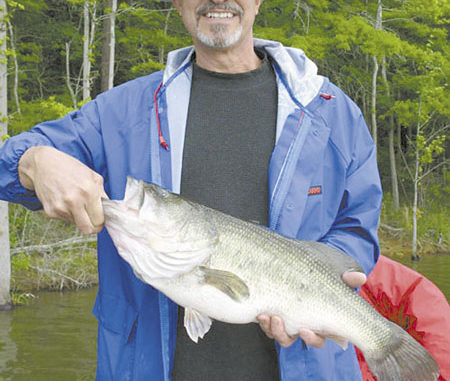
You can still crank up some good largemouths from Jordan Lake’s deep water, if you take the advice of these two experts.
Like the old gray mare, B. Everett Jordan Lake ain’t what she used to be — but she’s still pretty good.
During the late 1980s and 1990s, Jordan’s outstanding fishery produced countless stringers of largemouth bass. During the prespawn and spawn, anglers could almost count on catching 6- to 10-pounders just about any time they visited the lake south of Durham.
During its heyday, tournament fishermen knew they had to put a 5-fish, 30-pound sack of bass on the scales to collect cash and trophies.
Phil Cable of Holly Springs, one of those competitors who later became a guide, landed a 14.38-pound largemouth in a March 1992 tournament that remains the lake record. Cable and partner Dennis Reedy of Sanford weighed in five bass that day totaling 45.68 pounds — a 9-pound average.
Nowadays, after the spawn and postspawn periods at the 14,300-acre reservoirs, many fishermen encounter a severe case of the shallow-water blues. The heady spring days of beating the banks, targeting brush, logs and stumps with spinnerbaits, buzzbaits, jig-n-pigs, soft-plastic lizards and worms end, for the most part, because bass don’t hold tight to every piece of shallow structure. Simply put, hot water drives Jordan bass deep each summer.
But for Cable and fishing partner Vinson Nettles of Hickory Mountain, June, July and August remain months to get their fair share of bass, even though fish are more difficult to find for most anglers. And some of their largemouths will be “hawgs,” although Jordan clearly doesn’t contain as many magnum largemouths as it once did.
“Early in (June), before the weather gets real hot — and if the water level is high — I’ll still throw crankbaits at stumps I know have been productive in the past,” Cable said. “I’ll also try also boat docks and rip-rap, particularly early in the morning or on cloudy, cool days.”
Baitfish (mainly threadfin shad) and crawfish hold at those areas, seeking food and cover.
The rip-rap at bridges crossing the lake, particularly the US 64 causeway, are favorite early-morning spots where Cable and Nettles try spinnerbaits and medium-diving crankbaits. Another favorite rip-rap area is the bridge and causeway across Beaver Creek adjacent to the Ebenezer Church ramp. The Bells Church Bridge north of Wilsonville on Farrington Rd. and Farrington Point Bridge just a little farther north also are favorite spots for blades and crankbaits.
Another outstanding early morning lure for rip-rap banks is a jerkbait, Nettles said.
“I started fishing Jordan Lake back in 1985 with (former guide) Mike Dinterman,” Nettles said. “We started out with a 10-foot john boat that had a trolling motor. Mike and I fished in the (Haw) river section. Then we got bass boats and learned to fish the entire lake.
“We won or placed high in a lot of Jordan tournaments in the 80s and 90s. One time, Mike was using a jig-and-pig in a tournament, and I was throwing a Lucky Craft jerkbait. He didn’t do well that day, but I caught five. Together, we had 40 pounds, and all came off rip-rap.”
Nettles’ largest Jordan Lake bass weighed 12 pounds, two ounces. That bass was hanging out on the rip-rap near Crosswinds Marina, and it smashed a Rat-L-Trap, a lipless crankbait.
When he was guiding on Jordan Lake, Dinterman (who now lives in West Virginia) said he concentrated his efforts at main-lake points during June.
“Bass start moving out onto those points that time of year,” he said. “I think they’re following baitfish that are coming off the banks. If you look hard enough, you might find a place where bass are stacked up, and you might catch five or 10 fish at one spot.”
Dinterman used a Carolina-rigged, watermelon-colored plastic worm to target bass at main-lake points in five to seven feet of water in early June.
“I’d gradually move a little deeper as the fish move offshore until I was fishing about nine feet deep,” he said. “That seemed like the break-over point; if bass were deeper, I got better results using a crankbait.”
Cable agrees somewhat with Dinterman’s analysis, but given his lure preferences, Cable would rather use crankbaits when bass are a little shallower, then work deeper water as the month moves toward July.
Cable often starts June days at Jordan with a Texas-rigged (¼-ounce bullet weight) 10-inch Zoom Ol’ Monster worm. He’ll use a ½- or ¾-ounce bullet weight when bass move to deeper water later in the month, or he’ll switch to a deep-diving crankbait.
“Sometimes (bass) want the worm, and sometimes they want the crankbait,” Cable said. “The reason I use big worms and big crankbaits is I believe larger baits draw strikes from bigger fish.”
But the real key to finding bass during June is water temperature, he said.
“When the (surface) water temperature gets to about 78 or 80 degrees, that’s when I start seeing bass seven to eight feet deep at the ends of flats,” Cable said. “It doesn’t have to be main-lake flats either. I’ve found fish at flats in deeper creeks.”
June largemouths move around at Jordan Lake, as they do at other lakes, so searching for hot spots is a key tactic for Cable and Nettles. Bass movements, besides being dictated by water temperature, often change daily because of wind shifts. Wind piles up plankton (baitfish food) and warmer water at different areas, and June bass follow baitfish.
Cable and Nettles usually try several spots on main-lake points or in feeder creeks close to deep water early in the month. Later on, when fish are deep, the two look for underwater structures that hold baits and bass.
“Sometimes you’ll find a main-lake point that’ll be hot, or fish might be at one particular creek,” Cable said. “You might go back to the same spot for three or four days and have good luck, but then bass will move out, following the baitfish. Then you have to start the process of looking again.”
When bass begin to move off the banks to find deeper comfort zones, Cable continues to use a crankbait or big plastic worm, depending upon what they want to eat that day. But he usually starts with crankbaits because hookups are more consistent. Bass are infamous for spitting out worms, but it’s tougher to shake a sharp treble hook that’s attached to a crankbait.
“I’ll put my boat in deep water off one of those flats and cast into four or five feet of water, then work a crankbait back to the boat,” he said. “That’s how I determine the depth fish are holding.”
Cable and Nettles also fish nearby Shearon Harris and Falls of the Neuse lakes, but Cable said Jordan lacks one characteristic that makes it better for bass during summer.
“What I like about Jordan is something it doesn’t have the others do — grass,” he said, referring to hydrilla, elodea, milfoil and primrose, underwater plants that are plentiful, especially at Harris Lake.
“Because Jordan doesn’t have much grass, the fish have to move away from the banks, and they’ll get on offshore structure when (the weather) gets hot,” Cable said.
When looking for deep bass, Cable first tries to find surface schools of baitfish. If not, his depthfinder comes in handy.
“(A depthfinder) won’t show up a lot of bass, but it will show baitfish schools near channels and drop-offs,” he said. “That’s where baitfish will be in summer, and you’ll usually find bass near them.
“Using a depthfinder to find fish when it’s hot discourages a lot of guys from fishing offshore in June because bass aren’t so easy to find. It’s not like spring when they’re shallow.
“You also have to know what you’re doing with a depthfinder and know what you’re seeing on the screen to catch largemouths at Jordan when the weather heats up. It takes some work to find deep bass at Jordan, but once you find them, you usually can catch bigger fish. You won’t catch a lot of bass, but the ones you do catch are likely to be good ones.”
Not only that, Cable said there’s always the possibility of hooking into a 10- or 12-pound striped bass while fishing deeper waters with a crankbait.
Cable uses a 7-foot, medium-heavy Quantum spinning rod when he’s not casting crankbaits. When it’s crankbait time, he uses an Abu-Garcia or Lew’s baitcasting reel. Nettles favors G-Loomis Dorado rods and St. Croix reels with 10-pound-test line.
“I like the spinning rod when it’s windy because you can cast it better in the wind,” he said.
Cable’s favorite crankbaits are Poe’s Series 400 or 400P lures.
“I’m not really cranking that deep,” he said. “People think you have to get down to 25 feet, but that’s not really the case. I catch most of my summer bass from 10 to 18 feet deep.”
Nearly any color of lure is fine with Cable — as long as it’s got some chartreuse.
“I like crankbaits in the ‘homer’ color —chartreuse with a green back — but I’ll also use chartreuse and brown or blue, and sometimes I like a bone (shad) color,” he said.
Cable said he almost always begins fishing a spot with a crankbait, then switches to a worm if bass don’t hit the hardbait.
“For soft plastics, I like centipede-style lures when I’m using a Carolina rig or a ½-ounce bullet-weight, Texas-rigged Ol’ Monster Zoom worm that’s 10 to 12 inches long.”
If he wants to hop a lure down a channel drop, Cable sometimes casts a Little George tail-spinner to the edge, then works it down the side into deeper water until he locates fish.
Cable also has a secret bass lure — a leadhead jig with a specific type of soft-plastic trailer — he’ll only reveal to paying clients.
“I found this lure once when I was saltwater fishing,” he said, “but it’ll also catch bass and stripers.”
When Jordan Lake first opened to the fishing public during the early 1980s, the N.C. Wildlife Resources Commission had no creel or bag limits, and anglers took tons of bass from its waters. Finally, the Commission instituted a 16-inch size minimum and 4-fish daily creel limit that helped stockpile lunker fish, but since then, sizes have dropped off.
“Fishing offshore structure at Jordan these days, you’ll likely catch mostly 2- to 4-pound bass with perhaps one or two 5- to 6-pounders,” Cable said. “You don’t hear of many 7- or 10-pounders caught anymore in
summer.”

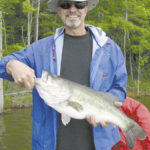
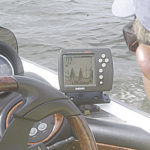
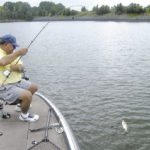
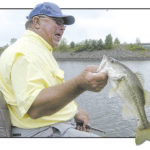
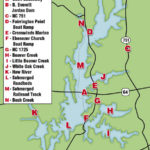

Be the first to comment